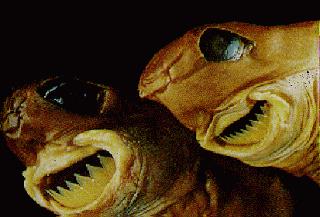
Thanks to e-How
The cookie cutter shark is a relatively small deepwater shark known for its rather unusual feeding habits and the round wounds it leaves on its prey items. There is still relatively little known about this elusive species, but better deep sea exploration and improved dissection techniques in recovered specimens have helped shed light on it. While the species is not considered threatened, they are difficult to find and observe due to their deep water habitat.
Appearance
The cookie cutter shark was once called the cigar shark due to the fish’s dark brown color and long, rounded shape. Most cookie cutters average 12 to 15 inches long, though specimens as large as 20 inches have been recorded. The shark has a distinctive, rounded jaw opening with somewhat fleshy lips and protruding lower teeth.
Habits
Cookie cutters have been observed at depths of over 11,000 feet, though it is highly possible that they travel deeper still. Like many deep sea species, cookie cutters generally rise to much shallower depths in search of prey during the night, and return to deeper water by daylight. Their range is vast, and specimens have been recovered in virtually every sea in the world. Like many other deep sea fish, they do not do well in captivity. Little is known about their reprodiction habits, except that females give birth to live young. Litters may average five to seven sharks, but that data was insufficient as of 2010.
Feeding
Considered a parasitic species, the shark attaches itself to large prey items such as squid, whales, and even other sharks by suctioning on with its fleshy lips. The shark then sinks its lower teeth into the flesh of its victim, and through a combination of swiveling its teeth and thrashing its body, removes an almost perfect circle of flesh from the prey animal-just like a cookie cutter. This process is normally over in a few quick movements, and most prey animals will recover with just a scar as evidence of the attack.
Other Adaptations
Large eyes help the cookie cutter see at extremely low light levels, which makes it very much at home in dark waters. The cookie cutter’s enlarged liver is filled with low-density oils that help the shark remain floating in its high-pressure deep sea environment. It also has a small bioluminescent patch on its abdomen, which glows to attract prey.
Interesting Facts
Cookie cutters shed their entire lower row of teeth all at once, rather than singularly like other sharks. This ensures that the shark has a razor sharp cutting edge at all times, and acts to prevent individual teeth from becoming dull and snagging in the flesh of prey items. Another point of interest is that the bioluminescent patch on the shark’s abdomen may continue to glow for up to three hours after its death.
Kathy Dowsett
www.kirkscubagear.com